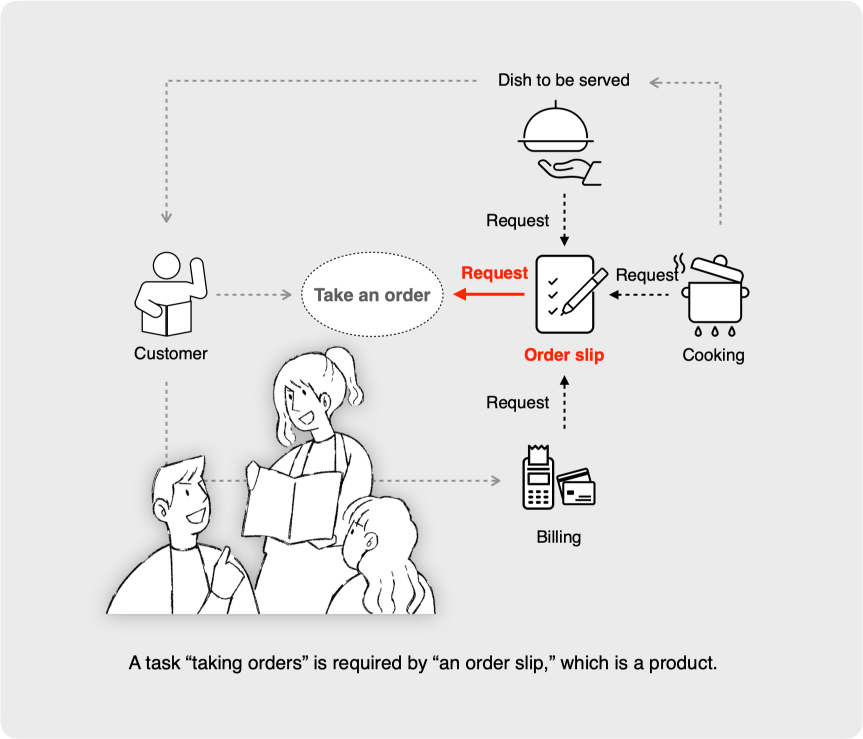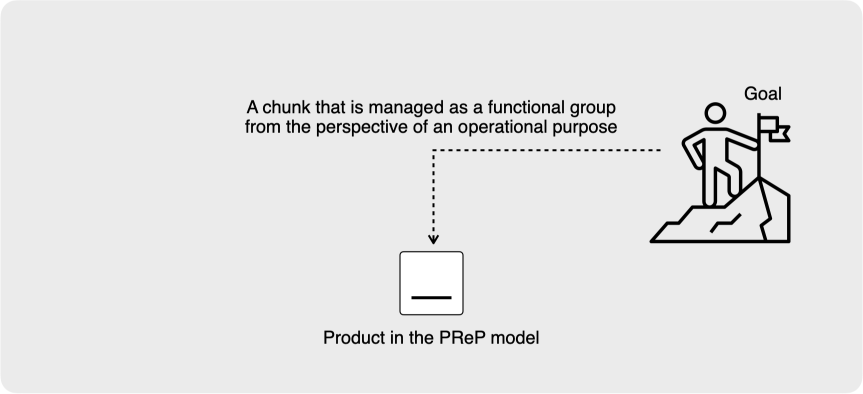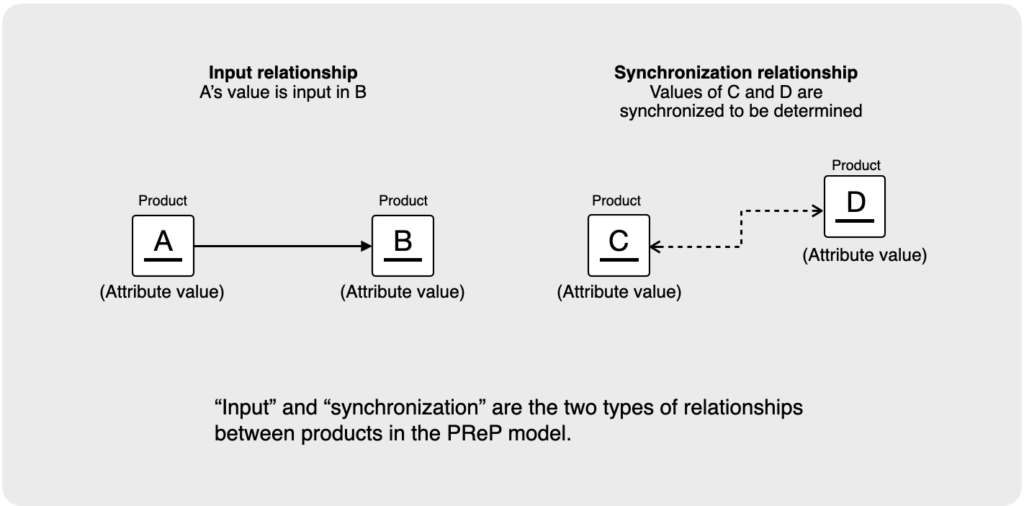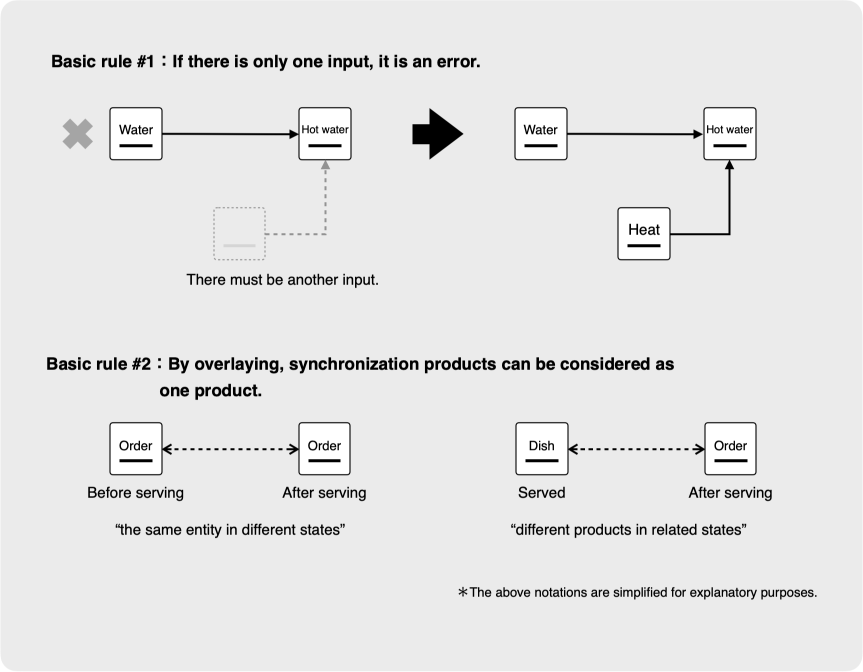“PReP” is an abbreviation for “Products Relationship Process.”
The PReP model is categorized as an entity-based process modeling method.
What is entity-based process modeling, and how do we model, analyze, and design processes using the PReP model? This section explains the basic idea.
For more detailed information on how to model actual processes using the PReP model and how to apply it to business improvement and system development, please visit the members’ page.
What is entity-based process modeling?
Let’s take a restaurant business as an example.
In floor operations, the tasks include “handling visitors,” “serving customers,” “receiving reservations,” “taking orders,” and “settling bills.” Why do we need each of these tasks? And do the tasks listed here cover everything that a waiter needs to do?
A restaurant can be defined as a business that receives compensation for services associated with serving food. To achieve a restaurant’s business goal, it is necessary to flawlessly connect cooking, serving, and billing for a customer’s order. Toward this end, an order slip is used to connect this series of processes.
In basic entity-based business modeling, this series of processes is depicted as follows: “an order slip is necessary to run restaurant floor operations; the slip requires a waiter performs the task of taking orders,” instead of “restaurant floor operations require a waiter performs the task of taking orders.” A particular task—in this case taking orders—is merely required by the product, the order slip. The task itself is not important because a waiter taking an order is only one of several possible ways to record an order. In fact, in a restaurant where customers themselves place their orders on electronic tablets, taking orders by a waiter is not necessary.
The PReP model, as an entity-based process modeling method, is a systematic way to accurately describe, analyze, and design a business process based on very simple rules.

Two perspectives to define a product
Defining “what” as an entity, or a “product” in the PReP model, is important in entity-based process modeling.
The PReP model defines a product from the following two perspectives:
1.A functional group from the perspective of an operational purpose; and
2.Something managed within a business process.

In the restaurant example, paper slips may be used, or they may be in electronic form from handheld terminals. Whatever the form, they function as “order slips.” Moreover, in a typical restaurant, an order slip is managed on a table-by-table basis, since services such as cooking, serving, and billing are performed on this basis.
Thus, in light of the restaurant’s operational purpose, the group of functions that flawlessly connects cooking, serving, and billing is called an “order slip.” In cognitive psychology, this act of giving a meaning from the functional perspective is called “chunking.” A “chunk” is a group that has been chunked.
The definition of a product in the PReP model is a chunk that is managed within a business process as a functional group from the perspective of an operational purpose.
Two types of relationship representations
In task-based process modeling, chronological and causal relationships between tasks are depicted. In contrast, entity-based process modeling represents logical structures between tasks.
The PReP model defines the logical structure of a process by the following two types of relationships, which are represented by a solid line arrow and a dotted line arrow, respectively.
1.Input relationship (solid line arrow)
2.Synchronization relationship (dotted line arrow)
An input relationship is a relation where values of products’ parameters are input. A synchronization relationship is a relation determined by the mutual influence of the values of products’ parameters.
Between the two types, the synchronization relationship is a defining method that characterizes the PReP model. Using a synchronization relationship enables conditional branches that appear in task-based process models to be drawn as a structure. This also saves us from the need to examine a process’s comprehensiveness to cover all conditional branches, while making it possible to draw a process structure in a simple way.

Two basic rules of relationships
We can logically validate our model using input and synchronization relationships. The following two rules tell us when “a relationship is non-viable (wrong).” These two logical verification rules are very important for drawing a correct process model.
- If there is only one input, it is an error.
When making hot water, water alone will not turn into hot water no matter how long you wait. Heat is needed to make hot water. Thus, if only one product—in this case water—is input, the relationship is an error. If only one input is depicted, it is assumed that there must be other input products to be identified. - By overlaying, synchronization products can be considered as one product.
Synchronization relationships are either “the same entity in different states” or “different products in related states.”
By combining the two rules, it is possible to verify all errors in structural relations.

The definitions and rules shown here are the basics of the PReP model. Detailed information on entity-based process modeling, actual methods for applying the model to business process improvement, and tools for generating system requirement definitions from business processes depicted by the model can be found on the members’ page.
The PReP Model Community is where members can exchange information with each other. To register as a member, click on the link below.
